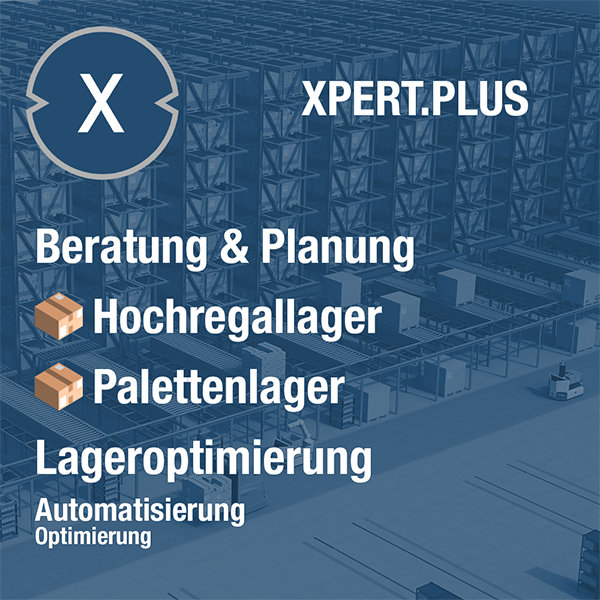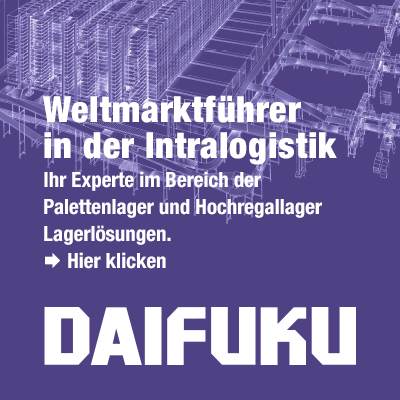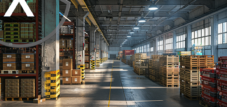Looking for a logistics planner and warehouse planner? The top ten tips for the correct planning of a warehouse – whether sustainable, new or for retrofit
Language selection 📢
Published on: July 27, 2024 / update from: July 27, 2024 - Author: Konrad Wolfenstein

Looking for a logistics planner and warehouse planner? Top ten tips for the correct planning of the warehouse – whether sustainable, new or retrofit – Image: Xpert.Digital
📊👷 The difference between a logistics planner and a warehouse planner
📦🔍📝 The world of logistics and warehouse management is complex and requires specialized professionals with different areas of responsibility to ensure efficiency and effectiveness. Two particularly important roles in this environment are the logistics planner and the warehouse planner. Both have crucial tasks that are closely linked but still have different focuses and responsibilities. Here I show the differences between a logistics planner and a warehouse planner and how both roles work together to ensure smooth operations.
🚛📅 The logistics planner: The architect of the supply chain
A logistics planner is essentially the architect of a company's entire logistics system. His main task is to develop and implement comprehensive logistical strategies. This includes the planning, implementation and monitoring of all logistics processes that are necessary for the successful operation of a company.
The core tasks of a logistics planner include:
Transportation planning
Ensuring that goods are transported efficiently and on time from production sites to warehouses or end users. This includes selecting suitable means of transport, route planning and coordination with external transport companies.
Supply chain management
Monitor and optimize the entire supply chain to minimize costs and maximize efficiency. The logistics planner works closely with suppliers, manufacturers and sales partners to ensure that all parts of the chain fit together smoothly.
Inventory management
Analyzing and forecasting inventory levels to ensure there are enough goods to meet demand while avoiding overstocking.
Cost control
Identification of savings potential within the logistics chain and implementation of cost reduction measures.
Technology and innovation
Integration of modern technologies such as automated systems, data analysis and artificial intelligence to increase the efficiency of logistics processes.
🏗️📦 The Warehouse Planner: The tactician of the warehouse system
In contrast, a warehouse planner focuses specifically on the processes within a warehouse. While the logistics planner develops the overarching logistical strategies, the warehouse planner implements these strategies operationally in the warehouse.
The main responsibilities of a warehouse planner include:
Warehouse design
Planning and organizing storage areas to ensure optimal use of available space. This includes deciding on warehouse layouts, racking systems and warehouse placement strategies.
Goods turnover
Ensuring an efficient flow of goods in the warehouse. The warehouse planner develops processes for storing and retrieving goods, picking and packaging.
Inventory management in the warehouse
Monitoring inventory levels and conducting regular inventories to ensure accuracy of inventory data. The warehouse planner works closely with the logistics planner to ensure that goods movements in the warehouse meet supply chain requirements.
Technology use
Integration and management of warehouse management systems (WMS) and other technologies to automate and improve warehouse processes.
Safety and sustainability
Implementing safety measures to prevent accidents and damage, as well as strategies to promote sustainability, such as recycling packaging materials and using energy-efficient techniques.
🤝🔗 Collaboration between logistics planners and warehouse planners
Although the roles of logistics planners and warehouse planners clearly have different focuses, their collaboration is critical to a company's success. A logistics planner develops strategies tailored to the needs of the entire business, while the warehouse planner implements and optimizes these strategies in the warehouse.
An example of this collaboration is the introduction of a new product. The logistics planner will plan the supply chain and transportation route to ensure that the product arrives at the warehouse in a timely and cost-effective manner. The warehouse planner, on the other hand, will ensure that the product is stored and prepared efficiently in the warehouse so that it can be shipped to customers quickly and accurately.
📈🌍 Challenges and solutions
Both roles have their specific challenges. The logistics planner must deal with global supply chains and possible disruptions, such as geopolitical tensions or natural disasters. A possible solution to this is to diversify supply chains and build buffer stocks to ensure flexibility.
The warehouse planner is faced with the challenge of efficient use of space and managing an increasing number of orders, especially in times of the e-commerce boom. Leveraging technologies such as automated warehouse machines and data analytics can help overcome these challenges and increase efficiency.
🔮📲 Logistics and warehouse planners increasingly important
With advancing digitalization and the new requirements arising from global markets and e-commerce, the role of logistics and warehouse planners is becoming increasingly important. Both must continually learn and adapt to keep up with the latest trends and technologies.
The future of logistics and warehouse planning will be heavily influenced by innovations such as artificial intelligence (AI), the Internet of Things (IoT) and big data. These technologies offer enormous potential to improve the efficiency and accuracy of logistics and warehousing processes.
Although the logistics planner and the warehouse planner have different focused tasks, their cooperation and mutual understanding are crucial to the success of a company. Each brings their specific skills and expertise to ensure that goods move efficiently and cost-effectively through the entire supply chain to the end customer.
In an increasingly complex global economy, logistics planners and warehouse planners remain indispensable players who, through their joint work, contribute to optimizing the supply chain and increasing a company's competitiveness.
📣 Similar topics
- 📦 Differences between logistics planner and warehouse planner
- 🏗️ The logistics planner: The architect of the supply chain
- 📍 Tasks of a logistics planner
- 🚚 Transport planning at a glance
- 🔗 Supply chain management and logistics planner
- 📈 Inventory management and cost control
- 🤖 Technology and innovation in logistics
- 🏫 The Warehouse Planner: The tactician of the warehouse system
- 📊 Warehouse design and goods turnover
- 🔧 Integration of warehouse management systems
#️⃣ Hashtags: #Logistics #SupplyChain #Warehouse #Technology #Efficiency
Xpert partner in warehouse planning and construction
📦🔧 Warehouse planner: The top ten tips for properly planning a warehouse - whether sustainable, new or for retrofit
🧩✨ Planning a warehouse can be complex and demanding, but requires careful preparation and a well-thought-out concept. Whether you are planning a sustainable warehouse, a new warehouse or want to optimize an existing warehouse, here are the ten best tips to help you create an efficient and highly functional warehouse.
🔍1. Comprehensive needs analysis
The first step in planning a warehouse is to conduct a detailed needs analysis. Understand the specific requirements of your business and the needs of your customers. Analyze the storage volume, the type of products to be stored and take seasonal fluctuations into account. A thorough needs analysis forms the basis for all further planning and decisions.
📍2.*Strategic location selection
The location of a warehouse plays a crucial role in its efficiency and cost-effectiveness. Choose a location that is strategically located to minimize transportation costs and delivery times. A location close to suppliers, manufacturing facilities or key markets can provide significant benefits. Also take into account transport connections, the availability of workers and the proximity to logistical hubs.
📏3. Optimal use of space and warehouse layout
Efficient use of storage space is critical to maximizing storage capacity and minimizing costs. Plan the warehouse layout to make optimal use of the available space. Consider the height of the warehouse and use vertical storage systems to make the best use of floor space. Also think about the arrangement of shelves and aisles to shorten storage distances and speed up picking.
🌱4. Sustainability in warehouse planning
The integration of sustainability aspects into warehouse planning is becoming increasingly important. Think about how you can make your warehouse more environmentally friendly. Photovoltaic systems on the roof, for example, can help reduce energy consumption. Energy-efficient lighting systems and temperature-controlled systems can also help reduce energy consumption. Sustainability also means minimizing waste and using recyclable materials.
🤖5. Use of modern technology
Modern technologies can significantly improve efficiency and accuracy in a warehouse. Invest in powerful warehouse management software (LVS) that helps you keep track of your inventory and automate processes. Automation technologies such as automated guided vehicles (AGVs), picking robots, and automated storage and retrieval systems (AS/RS) can increase productivity and reduce errors.
🔄6. Flexibility and scalability
A warehouse should be planned to be flexible and scalable to respond to changes in demand. Modularity is a key word here. Modular shelving systems and flexible warehouse layouts allow you to expand or adjust the warehouse as needed without causing too much disruption to ongoing operations. A flexible design also makes it easier to integrate new technologies and processes.
🔐7. Safety measures for people and material
Safety in the warehouse has top priority. Ensure all safety precautions are taken to protect both employees and stored goods. This includes surveillance systems, fire protection devices and clear safety protocols. Training and regular safety checks are also essential to ensure a safe working environment and avoid accidents.
💺8. Ergonomics and workplace design
The ergonomics and design of workplaces in the warehouse have a direct impact on the health and productivity of employees. Make sure workstations are ergonomically designed to minimize strain and increase efficiency. Height-adjustable work surfaces, ergonomic tools and well-organized work areas help employees work efficiently and healthily.
🔗9. Integration into the supply chain
A warehouse is an integral part of the entire supply chain. Seamless integration into the supply chain facilitates communication and data flow between suppliers, the warehouse and customers. Well-integrated warehouse management software can help streamline processes and improve inventory accuracy. By integrating into the supply chain, you can also identify potential bottlenecks at an early stage and react to them proactively.
🔧10. Retrofit planning for existing warehouses
It is not always necessary to build a new warehouse. It can often make more sense and be more cost-effective to optimize an existing warehouse. Retrofit planning aims to analyze current weaknesses and challenges and carry out targeted upgrades. This could include integrating new technologies, optimizing workflows or adopting sustainable practices. A retrofit often brings greater efficiency and cost savings without completely changing operations.
Careful planning and a well-thought-out strategy are crucial to making a warehouse efficient and future-proof. From needs analysis to location selection to integrating modern technologies and sustainable practices, there are many factors to consider. By implementing these top ten tips, you can ensure that your warehouse not only meets current needs, but is also flexible enough to adapt to future changes.
📣 Similar topics
- 📊 Comprehensive needs analysis: The first step to successful warehouse planning
- 📍 Strategic location selection: Key to efficiency and profitability
- 📐 Optimal use of space: How to maximize your storage capacity
- 🌿 Sustainability in focus: environmentally friendly storage solutions
- 🤖 Use of technology: Modern solutions for more efficiency
- 🔄 Flexibility and scalability: Adaptability of warehouse planning
- 🔒 Safety measures: Protection for people and material
- 👷♂️ Ergonomics and workplace design: health and productivity in the warehouse
- 🔗 Integration into the supply chain: Seamless processes and optimization
- 🔧 Retrofit planning: Efficiently upgrade existing warehouses
#️⃣ Hashtags: #warehouse planning #sustainability #technology #security #supplychain

Xpert.Plus warehouse optimization - high-bay warehouses such as pallet warehouses consulting and planning
We are there for you - advice - planning - implementation - project management
☑️ Smart City & Factory: Industry expert for energetic 5G buildings and halls as well as advice and installation of solar systems
☑️ Xpert.Plus - logistics consulting and logistics optimization
☑️ Industry expert, here with his own Xpert.Digital Industry Hub with over 2,500 specialist articles
I would be happy to serve as your personal advisor.
You can contact me by filling out the contact form below or simply call me on +49 89 89 674 804 (Munich) .
I'm looking forward to our joint project.
Xpert.Digital - Konrad Wolfenstein
Xpert.Digital is a hub for industry with a focus on digitalization, mechanical engineering, logistics/intralogistics and photovoltaics.
With our 360° business development solution, we support well-known companies from new business to after sales.
Market intelligence, smarketing, marketing automation, content development, PR, mail campaigns, personalized social media and lead nurturing are part of our digital tools.
You can find out more at: www.xpert.digital - www.xpert.solar - www.xpert.plus


























